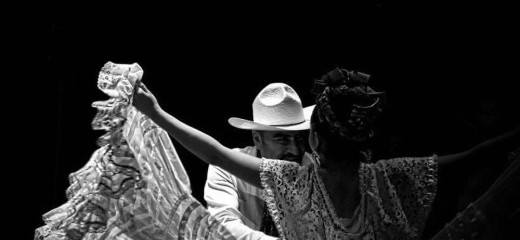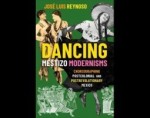
Queering the Archive of lo Mexicano
by Amy Schofield
As a flamenco dance researcher, I’m interested in the ways dance functions as a practice of nationalism. While flamenco usually comes to mind when one pictures dances of Spain, ballet folklórico may be what one imagines when they consider national dances of Mexico. Winner of the 2023 Dance Studies Association de la Torre Bueno First Book award, Manuel R. Cuellar’s Choreographing Mexico: Festive Performances and Dancing Histories of a Nation looks at Mexican “regional and traditional dance” (161) from the 1910s to the 1940s in public festival performances, parades, and cinema. While Cuellar is primarily a scholar of Latin American literature, his debut book argues for the need to expand the archive to include embodied practices. Analyzing photographs, newspapers articles, and footage from festivals and Mexican cinema, Cuellar’s work approaches archival research from a queer decolonial perspective. As a folklórico dancer and choreographer himself who has performed and taught in both Mexico and the United States, he analyzes archival material with extensive embodied knowledge of the form.
Choreographing Mexico’s significance lies in its use of dance and performance to “reveal the contradictory interaction between representations of national identity, representations of Mexicanness, and the dance’s embodiment” (6). Cuellar argues that dancing bodies in public performance often simultaneously adhered to and subverted nationalist ideologies of post-revolutionary modern Mexico. While much research has been done on post-revolutionary Mexican modernism in literature and visual art (specifically muralism), Cuellar adds to the discourse with his emphasis on dance and the moving body as displays of lo mexicano (Mexicanness). The ephemerality of performance and the possibilities of the dancing body, according to Cuellar, allow for multiple interpretations and iterations of Mexicanness to be on display simultaneously.
The book’s first two chapters discuss the ways bodies move through space in public performances and festivals, particularly how the presence of Indigenous and rural dancers and spectators factored into displays of Mexican modernity and the legacy of coloniality. Perhaps because of the nature of the primary sources available for analysis, I found myself craving more movement description of the dances he mentions in these two chapters. My wish was granted in the book’s third chapter, which turns more directly to choreographic analysis in its discussion of Nellie Campobello, a “pioneer in the creation of dance as a nationalist discipline in postrevolutionary Mexico” (121). Cuellar analyzes performances of Nellie Campobello and her sister Gloria through a queer subversive lens to highlight the ways their embodiment of lo mexicano both aligned with and countered Mexican nationalist ideology of heteronormativity and gender. I found Cuellar’s queer reading of the Campobellos’ rendition of El jarabe tapatío of particular interest. With the two women dressed as a heteronormative Mexican couple, el charro and la china poblana, the sisters simultaneously upheld a nationalist rhetoric of heteronormativity while subverting it through a centering of, and queering of,womanhood.
The book’s final chapter turns to the Golden Age of Mexican cinema (the 1930s and 1940s) to look closely at the function of race in discourses of national belonging and modernity. Cuellar attends to an auto-ethnographic analysis of his own folklórico dance practice and the implications of the coloniality of the archive in the book’s epilogue. He addresses the ways knowledge is circulated, and how an attention to dance disrupts and complicates Eurocentric ideas of knowledge production and transmission. For Cuellar, Mexican popular dance is “a generative site of political enunciation” (x), asking how embodiment and the physical presence of bodies in space factor into cohesive ideologies of modern Mexico.
In the tradition of performance studies scholar Diana Taylor’s distinction between the archive and the repertoire,Cuellar accounts for tangible (primary source documents) and intangible (how these ideas manifest in dancers’ bodies) evidence. How can real bodies moving within a cultural tradition supplement and/or provide contradictory information to what appears in the archive?
Drawing from the works of Latinx queer theorists such as José Esteban Muñoz, Juana María Rodríguez, and Ramón Rivera-Servera, Cuellar’s queer archival research attends to the invisibilized, unrepresented, and under-represented. By analyzing the archive in this way, Cuellar argues that the bodies that danced Mexican nationalism, while upholding the ideologies of the time, were also able to defy norms and push boundaries and expectations of gender and race.
Cuellar’s project advocates for an attention to dance and embodiment as a meaning-making practice and informs our understanding of how Mexican nationalism was choreographed onto the body. A wealth of archival images interspersed throughout the book compliments Cuellar’s analysis. Heavy on theory, Choreographing Mexico would appeal to dance graduate students and scholars of Mexican history, nationalism. While Cuellar does provide brief historical background information, some of this book’s contribution may be lost to readers without prior knowledge of the Mexican colonial era, Afro-Mexicanidad, ideologies of mestizaje, and post-revolutionary Mexican politics. That being said, Cuellar’s incorporation of his own experience as a teacher and dancer grounds the work’s significance in the present and adds important and overarching insight to the ways dance forms community and contributes to individual and collective identity formation.
Manuel R. Cuellar, Choreographing Mexico: Festive Performances and Dancing Histories of a Nation. Austin: University of Texas Press, 2022.
https://utpress.utexas.edu/9781477325162/
By Amy Schofield
December 18, 2023










